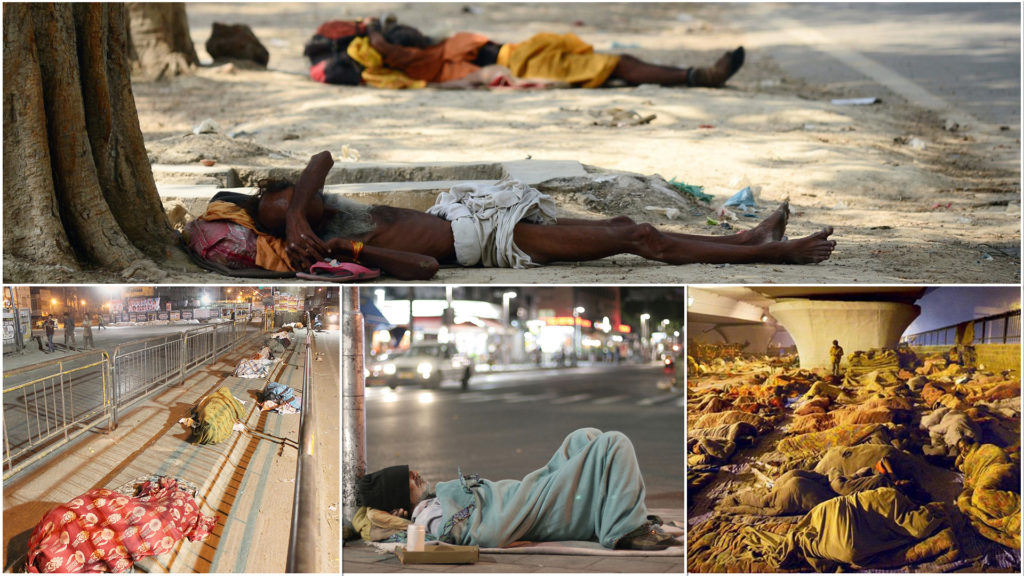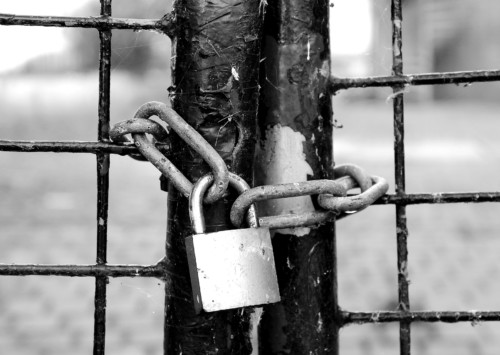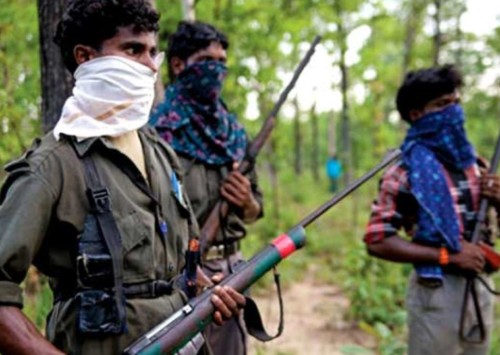Urban homeless in India
The three-member panel appointed by Supreme Court in their final report revealed that almost 90 pc of the urban homeless in India is yet to get a shelter; the ambiguity in handling government funds and fallacious undertakings of the state governments came as striking facts in the report.
The figures revealed by the 2011 census against the 2001 census found the number of homeless families in India increased by 0.49 pc whereas urban homeless families in a decade increased by 36.78 pc growing from 1,87,810 to 2,56,896. The exact increase in homeless population from 2001 to 2011 was 7,78,599 to 9,38,348 – a rise of 20.51 pc. The 2001 census found that 20.53 pc of the population in India resides in urban areas. In 2011 census the urban population reached 31.16 pc. According to the UN State of the World Population report in 2007, India’s urban population is set to reach 40.76 pc by the year 2030. Owing to the rapid migration of the rural and semi urban population to cities in search of employment over the last two decades the recent figures of urban homeless is projected to cross 2 million in India.
According to another report by the Housing and Land Rights Network (HLRN), an NGO based in New Delhi, 31 pc of India’s population (about 380 million) live in urban areas. By 2030, India’s city dwellers are projected to reach 600 million. The number of families unable to afford a house could reach 38 million by 2030. Almost two-thirds Indian cities have informal slum settlements and more than 13 million households live in them. And more than a third of families living in such settlements do not have basic amenities like electricity, piped water and sanitation within their premises. The agrarian crisis, failed land reforms, drought and floods and lack of employment opportunities have forced the rural population to migrate to cities. While India hopes to reside in Smart Cities, the HLRN report calls it faulty arguing that the funding is discriminatory and lacks human rights indicators, especially for the low-income groups.
Supreme Court panel report
To improve the living standards of the people below the poverty line and those who seek shelter under flyovers and bridges in the cities, the government of India has a separate ministry rolling out funds and monitoring the development of the situation. However, the recent report submitted by the three-member panel led by retired Delhi High Court Judge Kailash Gambhir reveals a story that is far from being hopeful. Since the launch of the National Urban Livelihoods Mission (NULM) in 2013, the Ministry of Housing and Urban Poverty Alleviation has released funds over INR 20 billion to the Indian states depending on their reports of urban homeless households.
In the short time span, the panel could visit 11 states and two Union Territories before drafting its report. Although the further functions of the panel are still awaiting a verdict from the Supreme Court, some of the report figures raise questions on the intent and aptitude of the state governments that failed to implement the NULM guidelines.
The 118-page report submitted by the three member panel throws light on a number of issues that India needs to address in terms of rehabilitation of the urban homeless. “We could visit only 11 states and two Union Territories within the stipulated time and we mentioned that in our report,” said Justice Gambhir in a telephonic conversation with MIG. “The case was adjourned as the Supreme Court said it needs time to consult and come to a decision after thoroughly reading the report. We are waiting for the next hearing,” he added.
Delhi improves on papers
According to the report, states such as Uttar Pradesh, West Bengal, Maharashtra, and Gujarat are still reeling behind in terms of providing shelters to the homeless families where as Delhi improved its figures compared to the 2011 census. The state witnessed a huge urban homeless rise in the 2011 census depicting a 139 pc increase in destitute families. However, the report compiled by Justice Gambhir and his team states that the state is yet to get NULM funds from the government and their visits to more than 50 shelter homes revealed that it has taken instrumental steps to improve the situation of the insolvent population. The report cites, “Delhi has taken a lead not only in establishing the maximum number of shelters but also some of the shelters are equipped with most of the norms as laid down under the DAY-NULM guidelines.”
Mizoram is the only state as per the panel report which has excess capacity to accommodate urban homeless. According to the 2011 Census, 104 urban homeless were identified when the capacity of 59 State shelters was 3059. The report finds that Aizwal the capital of Mizoram is the only city that does not require an additional road-map for the establishment of shelters to meet target 2022.
Right to live with dignity
As migration to big cities in search of employment in the developing countries increased the issue of urban homeless has already reached a status of global phenomena. While the Universal Declaration of Human Rights 1948 says that everybody has the right to a standard of living that is adequate for the health and well-being of the person and the family, the circumstances for the urban homeless households deteriorate every year.
In 2003, two separate Writ Petitions were filed by E R Kumar (Writ Petition [civil] no.55 of 2003) and Deepan Bora (Writ Petition [civil] 572 of 2003) wherein the focus was shelter, basic and necessary amenities for the homeless urban population in all the states and union territories in India. The petition observed and questioned the purpose and a shift of intention of the ‘right to live’ to the ‘right to live with dignity’. The moot cause was simple; the urban homeless have a significant contribution to a city’s economy and development but are deprived of the basic necessities of life.
The backdrop of the report still remains these two Writ Petitions and Justice Gambhir said along with his panel members tries to uncover the ambiguities, functional fallacies and immature undertakings of the states in their report.
A good night’s sleep can be a matter of life and death in urban India https://t.co/JozkUYt4nL #homeless #India pic.twitter.com/OVFUYMfvV3
— WHO Urban Health (@who_urbanhealth) November 13, 2015
Target 2022
The Ministry of Housing & Urban Poverty Alleviation had laid down a target of 2022 to provide shelter to each and every homeless household in the country. Abiding by the pledge, the central government has allocated funds to the state governments and Union Territories over the last four years. However, the report points out that ambiguity in the functioning and the bureaucratic situation in various Indian states have made the progress rather tardy and arduous. “The project seems dreamlike as of now if you look at the slow progress,” said Justice Gambhir. The concluding section of the testimony clearly outlines that there should not be any kind of let up or laxity and more vigorous efforts with all zest and zeal should be made by all the concerned to turn the said dream into reality.
In a hopeful note, Justice Gambhir adds, “I saw a lot of motivation during our visits to the states and union territories. The NGOs, the police, the state secretaries, senior officials of the states, municipal corporations and sometimes people from the media came to our interaction and presentation sessions.”
These interactions and presentations have also cleared the air of doubt in the minds of the stakeholders and also initiated activation of state administrations. Roadmaps were also submitted by most of the states to meet the laid down targets of providing a roof over the heads of the urban homeless by the year 2022.
Kolkata cuts a sorry figure
The observations of the report on the eastern metropolis Kolkata is particularly adverse. The city has the highest number of urban homeless in a metropolitan city in the country and is yet to have a proper plan to provide shelter; even the survey for identification of urban homeless is yet to be conducted.
According to the 2011 census, the streets of Kolkata were home to 69,798 urban homeless and the capacity of shelters provided was mere 1588. There was a huge gap between the capacity of existing shelters and number of urban homeless in the city. Quite surprisingly, Kolkata even now is above Mumbai in terms of the urban homeless population.
Road ahead
Justice Gambhir and his team in their report have suggested 35 crucial points to improve the state of things in terms of the dejected and homeless in the urban areas of India. The committee also requested a clear demarcation of the funds allocated to the states under the housing and urban poverty alleviation section to avoid ambiguous spending. Some of the imperative guidelines mentioned by the report were, city-wise homeless survey, quarterly third-party quality audit, and social audit of the shelters, computerisation of the enrolment and profile of the homeless and engaging reputed NGOs and trained staff for operation and management of shelters.
Adding value to our research, V Suresh the Founder Trustee, Good Governance India Foundation and Former CMD of HUDCO commented on the situation of homeless and how the identification remains the key. He said, “The issue of homeless living on footpaths pavements, below flyovers etc, is different from inadequately housed people living in slums and other habitats. These are nomadic people and representing an informal sector that is living below poverty line. What they need is Night Shelters or Raen Baseras.”
“It is not a land development and house building issue with infrastructure as a physical building programme. Poverty alleviation and temporary shelters followed by formal housing is the way forward,” said the former HUDCO man. “What needs to be done is to integrate NULM and PMAY inputs in a holistic manner. The identity or location base of the homeless population had to be closely monitored to implement alternate shelter solutions,” Suresh added.













